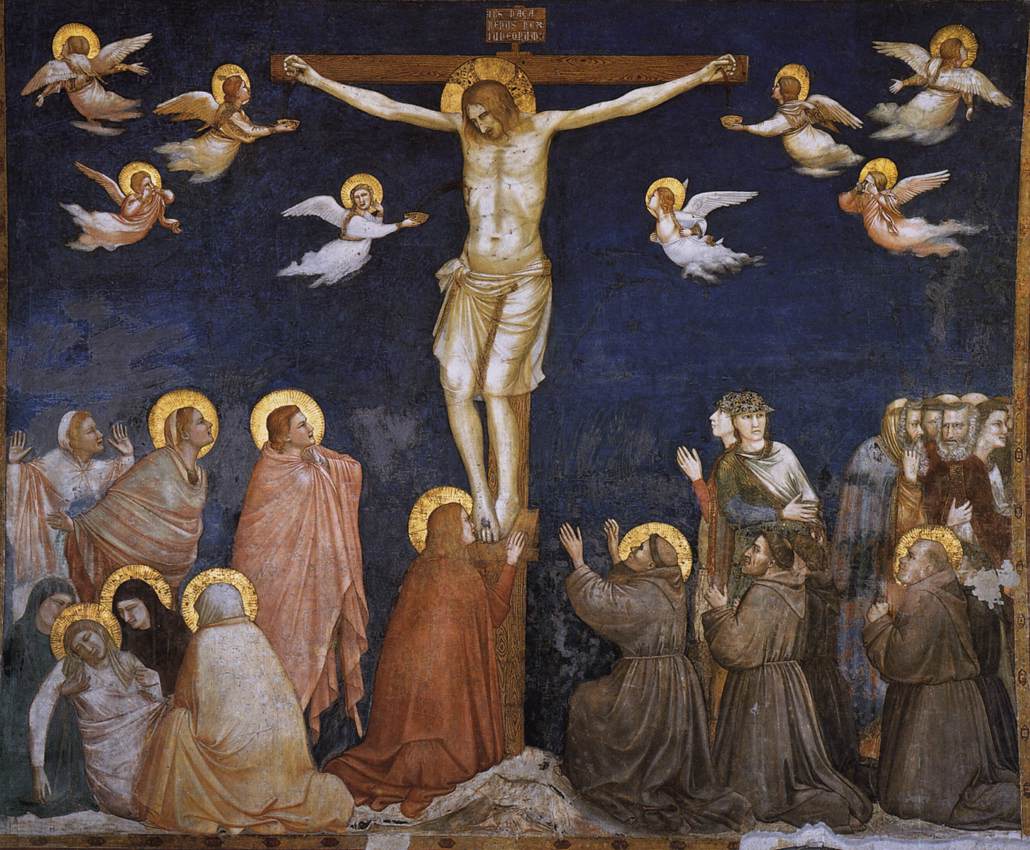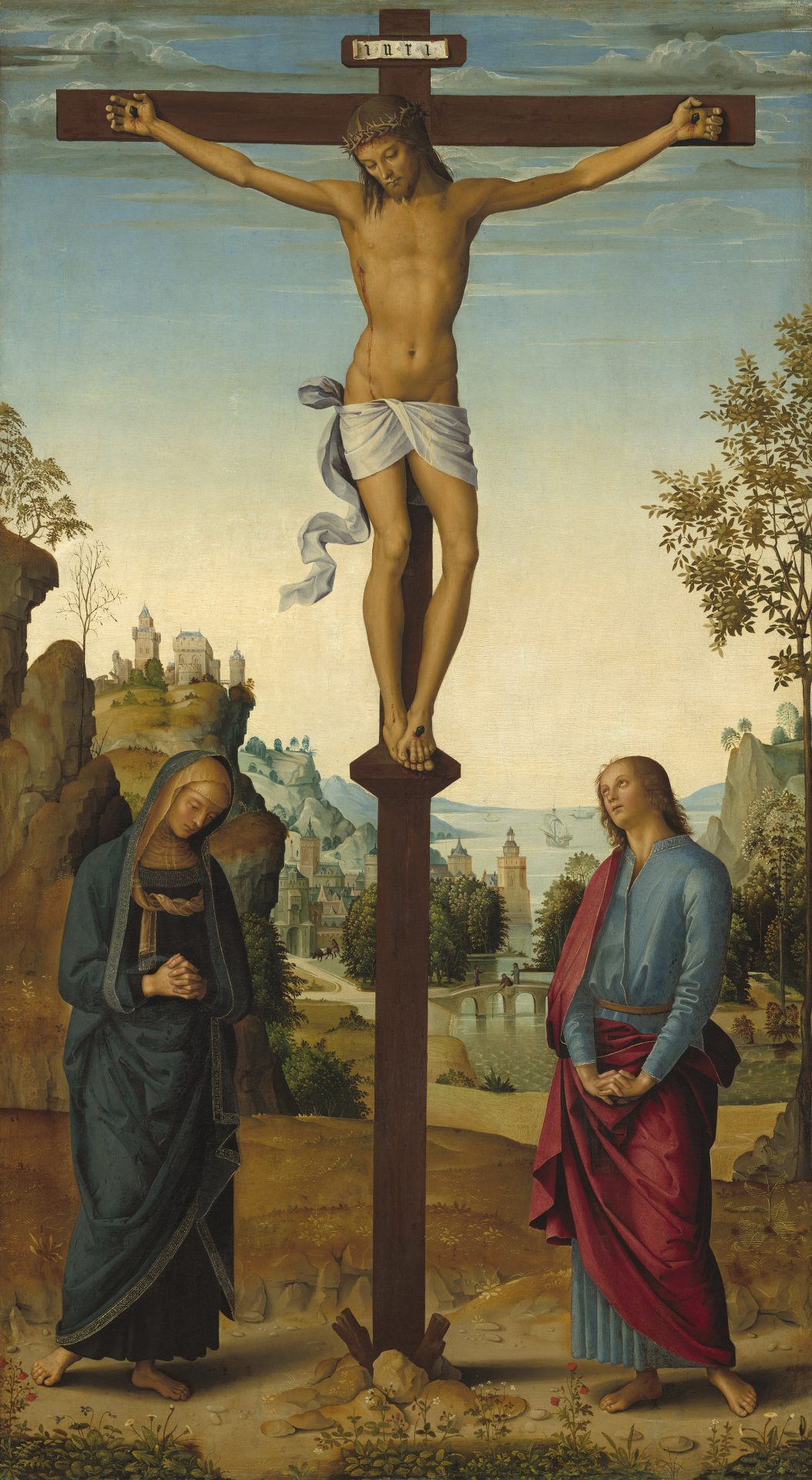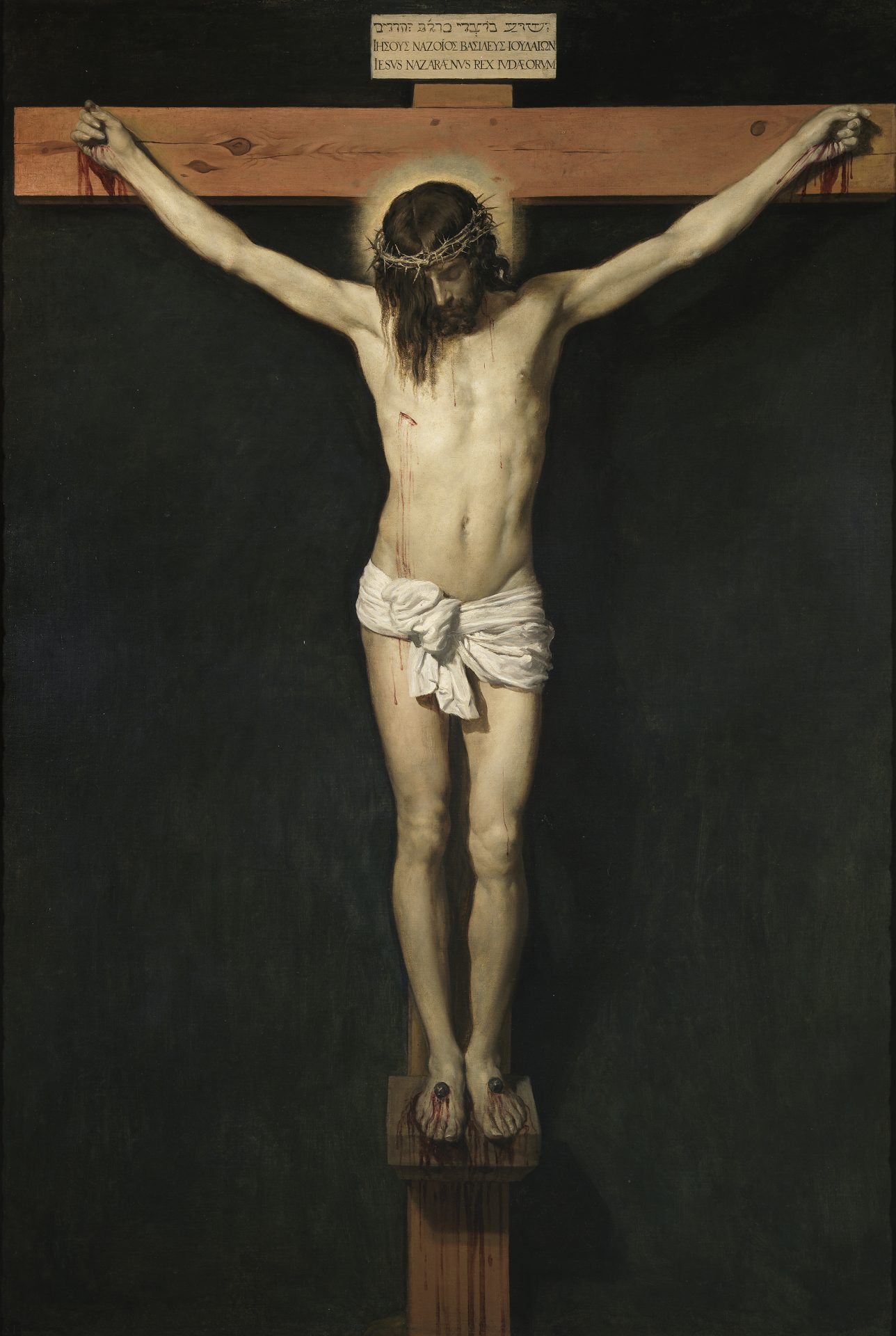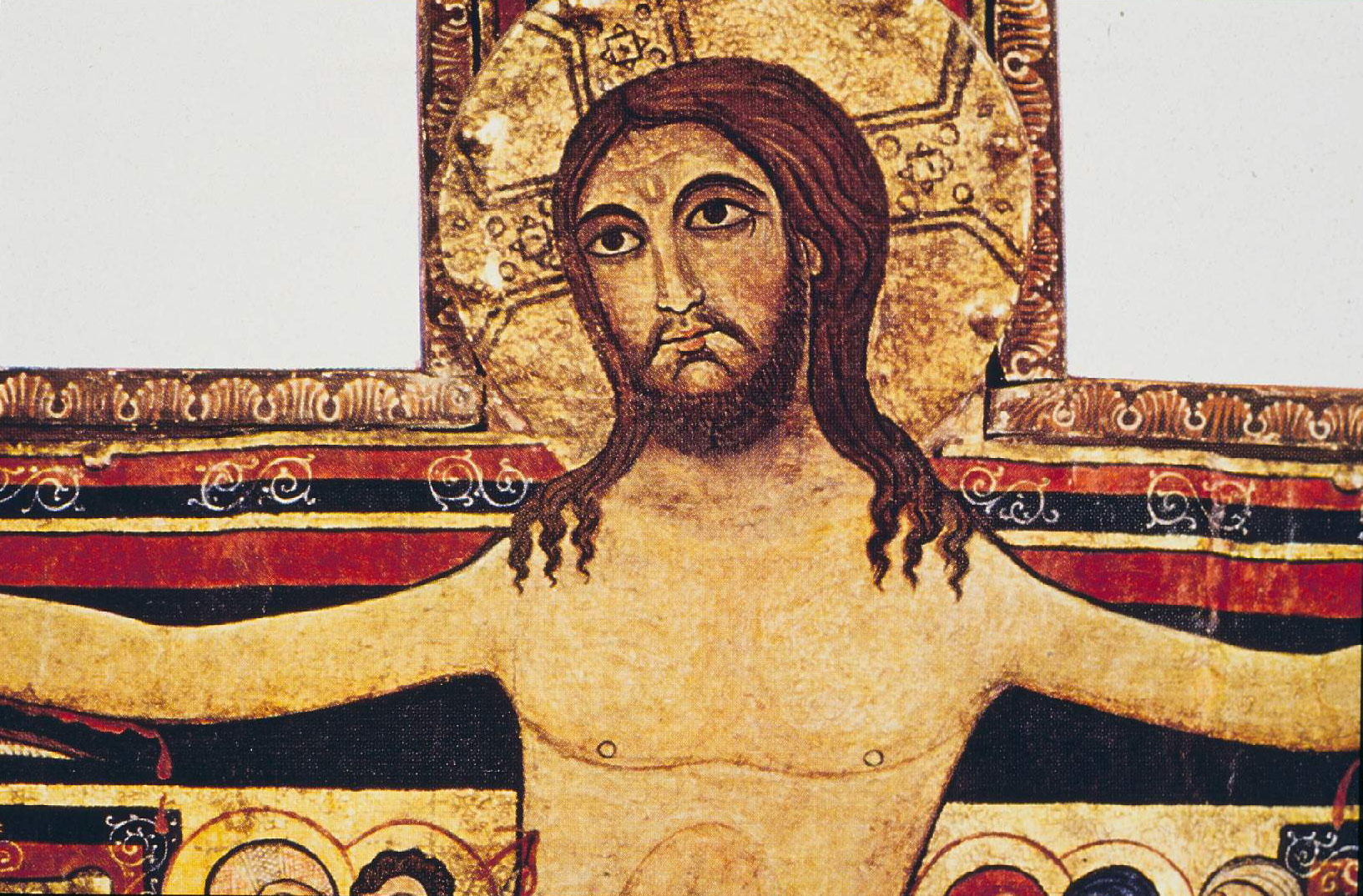
(The Crucifixion, Giotto and collaborators,1308-1310 in the Lower Basilica of Assisi)
Friday 7th April
GOOD FRIDAY – YEAR A
Matthew 27, 32-56
We are at the height of the story of salvation within the liturgy of the Easter Triduum. We invite you to slow down, take the time to study and pray on these verses of the Word. The reading of passages from Matthew’s Gospel during these solemn days is focused on the location of the facts, immersed in creation. An olive grove, a mountain and a garden. Today we are on Mount Golgotha, a place of torture and death. We are faced with the most important story of the whole Gospel. Here, today, in this mount outside Jerusalem, we have the opportunity to encounter this face of God. Yesterday, in the olive grove, Jesus taught us how to pray. Today He teaches us how to live.
This is why “telling” today is an impossible task, we can only suggest a few ideas, with an invitation to all of you to slow down, to put on the brakes today and focus your gaze on every single verse. Each step would merit a day, or a week of silent meditation. In each verse, we find explanations of all Scripture, of the prophets, of the law, of Paul’s letters, of the apocalypse, patristics, medieval theology, the magisterium of the church, Laudato Si’. Here we meet the creation that speaks to us of this death, the darkening sky, the veil of the temple – made of human hands – that is torn. It is up to us to choose whether or not to fix our gaze on the glory of God, which is manifested today in the lacerated body that hangs from the cross, just as the evildoer and the centurion do and therefore be saved or to act as the high priests, the Pharisees and the crowd, who make fun of what’s before them, but who are nevertheless saved by the mercy of God.

“As they were going out, they met a Cyrenian named Simon”, the scene opens with an immigrant from Libya in Africa, a “poor Christ” who was returning from working in the fields. Whoever carries crosses or helps to carry them, is never a rich or powerful person but always someone who is looked on as inferior. Despite this, this man becomes one of the protagonists of the scene. It is not Simon the disciple on whom He will found the church, but another Simon. An involuntary disciple who goes on to follow the Christian way and in fact with his children and his wife Evodia, is mentioned both in the letter to the Romans and in the Gospel of Mark as the father of Alexander and Rufus.
When suffering, we almost always look for some form of anesthetic “they gave him wine mixed with gall to drink”, but He refused to drink it. The scene where they stripped Him of his clothes is always heartbreaking and humiliating then, “they divided his garments by casting lots“. The majesty of God in having nothing of one’s own. “Two robbers were crucified with him, one on the right and one on the left.” The cross is like a tree that stands on this mountain, it reminds us of the tree of life rejected by Adam (whose skull is often represented at the foot of the cross). Jesus climbs this tree of death to spill His blood on the skull, which represents the death of each of us, in order to give life. His blood irrigates the soil like the blood of many eco-martyrs who fight for social and environmental justice. The blood of martyrs is the seed of Christians, as Tertullian says. In this moment of Christ’s glory the two criminals are present “one on the right and the other on the left” in the exact places where James and John so anxiously desired to be. How we need to learn to pray! Keeping Jesus in our midst, among our miseries, in solidarity with all humanity represented on the right and on the left: those who are criminals and those who are convinced that they are not.
How much we, Christians and citizens of the world, have to learn from this prophetic image! When we understand that true politics is not about occupying positions of power to defend with the crusades and with political parties, but putting the “last of the last” in first place, truly listening to the cry of the poor and the earth. Then we can truly hope for a better world. How important it is that Christians commit themselves to a prophetic policy! If our king is Jesus crucified, then there truly is hope. It is a solid hope, because together with a world made up of a minority of kings who feed wars, abuses, corruption, in history man has also known human rights, solidarity, and integral ecology, built by many kings who choose, in silence and every day, to put themselves at the service of others.
“Those who passed by” together with the “chief priests, with the scribes and the elders” and moreover “even the robbers crucified with him reviled him in the same way”. A unanimous chorus of criticisms and insults, to this God who shows his majesty from the wood of the cross. And how current is this word, how many criticisms of this God who accepts suffering, who takes charge of our crosses?

(Pietro Perugino, Crucifixion, 1482 ca, Washington, National Gallery of Art)
“From noon onward, darkness came over the whole land until three in the afternoon”.Creation speaks to us every day. But today everything takes on a particular meaning, we find ourselves in a night that begins in the garden of the oil mill in Jerusalem, which was marked by trials and outrages, by the confusion of the road, by the Mount of the Skull. Apparently we are in the sixth hour, the hour when the sun is at its highest point, the hour of greatest light, but also the hour of Adam and Eve’s disobedience. Sin as a moment in which creation detaches itself from the Creator, and in fact Adam and Eve hide themselves. Darkness hides from the strongest light. The end of the world takes place on the mountain of Golgotha. The world of sin ends. We do not have to wait for another end of the world, in the Gospels it is already described here, with this eclipse.
“My God, my God, why have you forsaken me?”. “But Jesus cried out again in a loud voice, and gave up his spirit”. We won’t dedicate a minute of silence; we invite you to dedicate, as you read this reflection today, ten minutes of silence or an hour of silence, contemplating on this theoria, this “show,” giving it the time it deserves.
Let’s dedicate silence in front of this image.

(Diego Velázquez, Christ on the Cross, 1631, Madrid, Museo del Prado)
He expired. Even God passed away. Life is about inhaling and exhaling. Having the terror of death is equivalent to being insatiable, often we just want to breathe in even to the point of bursting. We keep the planet’s resources, relationships, well-being, our own life to ourselves, in fear of losing them. God, who created everything with an action of kenosis, stripping himself of his infinity to leave room for finite things, now in the stripping of the cross gives us a new creation. A new birth. Without veils, God reveals himself to us. Expiring.
The passage closes, mirroring how it opened, with the categories that attended this show: power, symbolized by the centurion, and crowds, that is, the people. In the story, the religious of the time disappear, their presence is lost in the events of this new creation.A new world begins, a new creation, “the curtain of the temple was torn in two.” The veil that hid the Holy of Holies is torn apart, God “reveals himself,” shows his face. The waters break. It is a painful birth; the Son is born, “calling out with a loud voice, said: “Father.” A birth in the pain and sin of the world. We are convinced in our minds that we are witnessing a death scene, when it is instead a birth.
“The centurion and the men with him who were keeping watch over Jesus feared greatly when they saw the earthquake and all that was happening, and they said, “Truly, this was the Son of God!”. A phrase that comes from the observation and contemplation of this cross. He says so, a man who exercised power and death by profession. We are the torturers of God, and despite everything it is we who can recognize him in the face of those who suffer.
St. Francis, in the stupendous paraphrase of the Our Father, reminds us: “And lead us not into temptation: hidden or manifest, sudden or insistent. But deliver us from evil: past, present and future.” (FF 274). We thank the Lord for the immense gift of his life for us, and for teaching us that an alternative path to evil can be taken. Let us pray on this day of silence that this new creation may be a seed of conversion for us.
Laudato si’!

(Crucifix San Damiano, unknown, XII secolo, Basilica Santa Chiara, Assisi)





